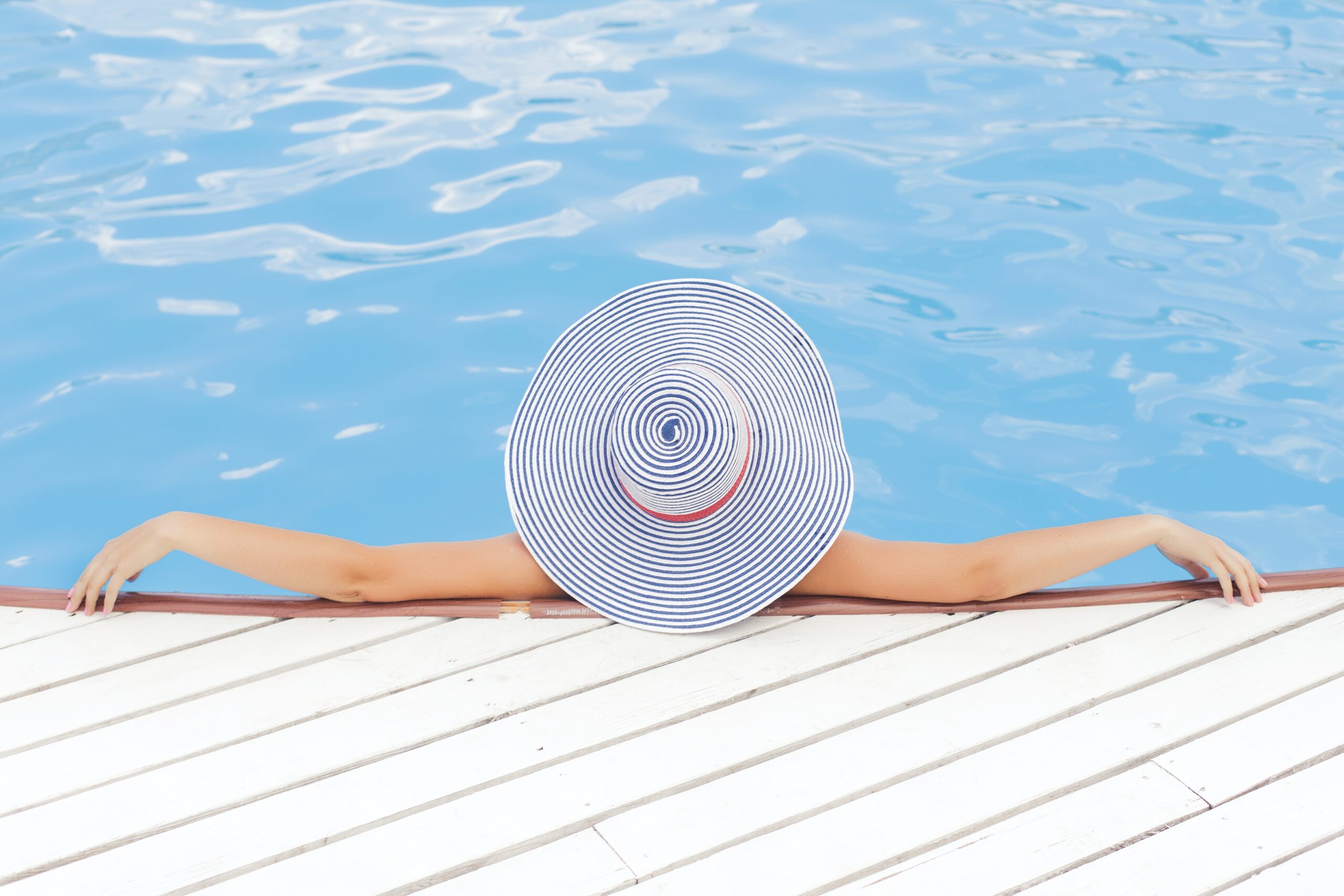So, winter is here and you’re left wondering how to keep your above ground pool nice and cozy during the chilly months. Well, fret not, because in this article, we’re going to explore some simple and effective ways to heat up your pool when the temperatures drop. Whether you want to extend your swimming season or just enjoy a warm soak on frosty days, we’ve got you covered. Say goodbye to icy waters and hello to a winter wonderland in your very own backyard.
This image is property of images.pexels.com.
Choosing the Right Pool Heater
Consider the Pool Size
When choosing a pool heater, it’s essential to consider the size of your pool. The size of the pool will determine the heating capacity required to heat the water effectively. Larger pools will require more powerful heaters, while smaller pools may only need a smaller heater to maintain the desired temperature. Take accurate measurements of your pool’s dimensions so that you can select a heater that can efficiently warm the entire pool.
Evaluate Fuel Sources
There are various fuel sources to consider when selecting a pool heater. The most common options include gas, electric, solar, and heat pumps. Each fuel source has its benefits and drawbacks. Gas heaters offer quick heating but may have higher operational costs. Electric heaters are reliable and cost-effective but may take longer to warm up the water. Solar heaters utilize the sun’s energy and are environmentally friendly, but their effectiveness may depend on the amount of sunlight available. Heat pumps are energy-efficient but may be more expensive to install initially. Consider your budget, energy efficiency goals, and availability of different fuel sources when choosing the right heater for your pool.
Determine the Desired Temperature
Before purchasing a pool heater, it’s important to establish your desired water temperature. This will depend on your personal preference and the intended use of the pool. If you plan to use your pool primarily for relaxation and leisure, a lower temperature may be sufficient. However, if you want to swim or exercise in your pool during the winter, you may need a higher temperature to ensure comfort. Consider your specific needs and ensure that the pool heater you choose can reach and maintain your desired temperature effectively.
Research and Compare Different Types of Heaters
To make an informed decision, research and compare different types of pool heaters available in the market. Each type of heater has its own advantages and disadvantages. Gas heaters are known for their quick heating capabilities, but they may require more regular maintenance. Electric heaters are reliable and easier to maintain but may have higher operational costs. Solar heaters utilize renewable energy and have lower operating costs, but their effectiveness can be impacted by the amount of sunlight received. Heat pumps are energy-efficient and environmentally friendly, but they may require a higher upfront investment. By comparing the features and costs of different heaters, you can find the one that best suits your needs and budget.
Calculate the Heating Capacity Needed
Once you have taken into account the size of your pool, fuel source options, desired temperature, and heater types, it’s important to calculate the heating capacity needed for your pool. Heating capacity is measured in BTUs (British Thermal Units) and signifies the amount of heat output required to raise the pool’s temperature efficiently. Factors such as pool size, desired temperature, and average air temperature in your region will influence the heating capacity needed. Consult a pool professional or use online calculators to determine the appropriate heating capacity for your pool, ensuring that you choose a heater that will effectively heat your pool.
Solar Pool Heater Installation
Assess the Available Sunlight
Before installing a solar pool heater, it’s crucial to assess the amount of sunlight your pool area receives. Solar heaters rely on solar energy to heat the water in your pool. Therefore, it’s vital to choose a location that receives ample sunlight throughout the day. Observe your pool area at different times and take note of any obstacles, such as trees or buildings, that may cast shadows over the pool. If your pool area does not receive sufficient sunlight, a solar heater may not be the most efficient option for heating your pool.
Select the Right Solar Collector Type
Solar pool heaters utilize solar collectors to capture the sun’s energy and convert it into heat. There are different types of solar collectors available, including unglazed collectors and glazed collectors. Unglazed collectors are affordable and generally used for warmer climates, while glazed collectors are more expensive but offer better performance in colder regions. Consider the climate of your area and consult with a professional to determine the most appropriate type of solar collector for your pool heating needs.
Determine the Ideal Placement for Solar Panels
After assessing the available sunlight and selecting the type of solar collector, it’s time to determine the ideal placement for the solar panels. Solar panels should be installed in an area that receives the maximum amount of sunlight. Typically, rooftops or open areas near the pool are suitable for solar panel installation. Consider the angle and orientation of the panels to optimize sun exposure. If necessary, consult a professional installer to ensure the panels are positioned correctly for maximum efficiency and performance.
Install the Solar Panels
Once you have determined the ideal placement, it’s time to install the solar panels. Solar panel installation should be done by a qualified professional to ensure safety and proper functioning. The panels are typically mounted and secured to a stable structure, such as a roof or a specially designed rack. The installer will connect the panels to the pool system, allowing water to flow through the panels and absorb heat from the sun. Hiring a professional for installation will ensure that the panels are correctly set up, minimizing the risk of damage or inefficient operation.
Connect the Solar System to the Pool
After the solar panels are installed, it’s important to connect the solar heating system to the pool. This involves integrating the solar panels with the existing pool plumbing system. Water from the pool is redirected to the solar panels, where it circulates and absorbs heat. The heated water is then returned to the pool, raising its overall temperature. Proper connection and integration of the solar system are crucial for optimal performance. It’s recommended to consult a professional to ensure that the system is correctly connected, avoiding any potential issues or damage.
Heat Pump Installation
Evaluate the Pool’s Electrical Supply
Before installing a heat pump, it’s essential to evaluate the pool’s electrical supply. Heat pumps require an adequate power source to operate effectively. Consult with an electrician to determine if your existing electrical system can handle the additional load of a heat pump. Depending on the size and capacity of the heat pump, you may need to upgrade your electrical panel or wiring. Ensuring that your electrical supply is sufficient before installation will prevent any power-related issues or damage to your heat pump.
Determine the Ideal Heat Pump Size
Selecting the right size heat pump is crucial for efficient pool heating. Heat pumps are available in different sizes, measured in British Thermal Units (BTUs) or kilowatts (kW). The size of the heat pump will depend on factors such as pool size, desired temperature, and average air temperature in your region. A heat pump that is too small may struggle to heat your pool effectively, while a heat pump that is too large may consume excessive energy. Consult a pool professional to determine the ideal heat pump size for your specific pool needs, ensuring optimal performance and energy efficiency.
Choose a Location for the Heat Pump
The location of the heat pump plays a significant role in its performance and longevity. Choose a well-ventilated area that allows for proper air circulation. Ensure that the location is easily accessible for maintenance and repairs. Avoid placing the heat pump near trees or other structures that may limit airflow or create shading. Proper placement will optimize the heat pump’s efficiency and ensure its longevity.
Install the Heat Pump and Connect the Plumbing
Heat pump installation should be done by a qualified professional to ensure proper functioning and safety. The installer will connect the heat pump to the pool plumbing system, allowing the water to flow through the heat pump and absorb heat from the surrounding air. The heated water is then returned to the pool, effectively raising its temperature. The heat pump should be properly secured and connected according to the manufacturer’s instructions. Hiring a professional installer will guarantee that the heat pump is correctly installed, minimizing the risk of operational issues or damage.
Set Up the Control Panel
After the heat pump is installed and connected, it’s important to set up the control panel. The control panel allows you to adjust the temperature settings and monitor the heat pump’s operation. Follow the manufacturer’s instructions to properly configure the control panel and familiarize yourself with its features. Understanding how to operate the control panel will enable you to optimize the heat pump’s performance and maintain the desired pool temperature efficiently.
Gas Pool Heater Installation
Check Gas Availability and Regulations
Before installing a gas pool heater, it’s crucial to check the availability of gas in your area. Ensure that a natural gas or propane supply is accessible for your pool heating needs. Additionally, familiarize yourself with any local regulations or permits required for installing and operating a gas pool heater. Compliance with regulations will ensure a safe and legal installation of the heater.
Select the Appropriate Gas Heater Size
Choosing the appropriate gas heater size is essential to ensure efficient pool heating. Gas heaters are measured in BTUs (British Thermal Units) and come in a range of sizes. The size of the gas heater will depend on factors such as pool size, desired temperature, and average air temperature in your region. It’s recommended to consult with a pool professional to determine the appropriate gas heater size for your specific pool requirements.
Choose a Location for the Heater
The location of the gas heater is an important consideration for both safety and performance. Ensure that the location provides adequate ventilation, as gas heaters produce combustion gases that need to be safely expelled. Choose an area away from flammable materials and low-traffic zones. Typically, gas heaters are installed outdoors, but they can also be placed in a well-ventilated pool equipment room. Consulting a professional during the location selection will ensure compliance with safety guidelines and optimal heater performance.
Install Gas Lines and Ventilation
Proper installation of gas lines and ventilation is crucial for the safe operation of a gas pool heater. Gas lines should be installed by a licensed professional who can ensure that they meet all safety standards and codes. Adequate ventilation is necessary to remove any combustion gases from the heater’s operation. The installer will properly connect the gas lines and install the ventilation system, ensuring that the heater functions safely and efficiently.
Connect the Heater to the Pool Plumbing
Connection of the gas heater to the pool plumbing system is the final step in the installation process. The gas heater is integrated into the pool plumbing to allow water circulation for heating. Water is redirected to the heater, where it is warmed up, and then returned to the pool. Proper connection of the heater to the plumbing system is essential for efficient and effective pool heating. It’s recommended to consult with a professional installer to ensure that the connection is correctly made, minimizing any potential issues or damage.
This image is property of images.pexels.com.
Electric Resistance Heater Installation
Ensure Adequate Electrical Supply
Before installing an electric resistance heater, it’s crucial to ensure that your pool’s electrical supply is sufficient. Electric resistance heaters require a stable and adequate power source to operate effectively. Consult with an electrician to evaluate your existing electrical system and determine if any upgrades or modifications are necessary. Ensuring that your electrical supply meets the requirements of the electric resistance heater will prevent any power-related issues or damage to the heater.
Choose the Right Heater Size
Selecting the right size electric resistance heater is essential for efficient pool heating. Electric resistance heaters come in different sizes, measured in kilowatts (kW). The size of the heater will depend on factors such as pool size, desired temperature, and the rate of heat loss in your pool. Consulting with a pool professional will help determine the appropriate heater size for your specific pool needs, ensuring effective heating and energy efficiency.
Determine the Proper Heater Placement
Proper placement of the electric resistance heater is important for its performance and longevity. The heater should be installed in a well-ventilated area with adequate airflow. Avoid placing the heater near flammable materials or low-traffic zones. Choose a location that allows easy access for any future maintenance or repairs. Proper placement will optimize the heater’s efficiency and ensure its longevity.
Install the Heater and Connect Wiring
Installation of the electric resistance heater should be done by a qualified professional to ensure safety and proper functioning. The installer will connect the heater to the pool plumbing system, allowing water circulation for heating. In addition, the electrician will connect the heater to the electrical supply, ensuring that the wiring is correctly installed and meets all safety standards. Professional installation will provide peace of mind and ensure that the heater operates efficiently.
Configure the Thermostat Settings
After the electric resistance heater is installed and connected, it’s important to configure the thermostat settings. The thermostat allows you to regulate the temperature of the heater and the pool water. Follow the manufacturer’s instructions to properly configure the thermostat and understand its operation. Understanding how to adjust the thermostat settings will enable you to maintain the desired pool temperature effectively and reduce energy consumption.
Covering the Pool
Invest in a High-Quality Pool Cover
Covering your pool during the winter is an effective way to retain heat and minimize heat loss. Invest in a high-quality pool cover that is specifically designed for winter use. A good pool cover will prevent evaporation and keep debris out of the pool, reducing the workload on your heater. Look for a cover made from durable and UV-resistant materials to ensure longevity and effective heat retention.
Choose Between Manual or Automatic Covers
Pool covers are available in both manual and automatic options. Manual covers require physical effort to put on and take off the pool, while automatic covers can be operated with a push of a button or a remote control. Consider your convenience and ease of use when choosing between manual and automatic covers. Automatic covers may be more expensive but can save you time and effort in covering and uncovering your pool.
Measure and Order the Correct Cover Size
Before ordering a pool cover, measure your pool accurately to ensure you purchase the correct size. A cover that is too small may not provide adequate coverage, while a cover that is too large may be difficult to handle and could potentially allow heat to escape. Measure the width and length of your pool, and choose a cover that matches these dimensions closely. Consulting with a pool professional or the manufacturer can help you determine the appropriate cover size for your pool.
Install the Cover Properly
Proper installation of the pool cover is important to maximize its effectiveness. Follow the manufacturer’s instructions carefully to ensure that the cover is installed correctly. Pay attention to any additional installation accessories, such as ropes or anchors, that may be needed to secure the cover in place. A tightly and securely installed cover will minimize heat loss and protect your pool during the winter months.
Consider Using a Solar Blanket or Liquid Solar Cover
In addition to a regular pool cover, consider using a solar blanket or a liquid solar cover to enhance heat retention. Solar blankets are designed to capture and retain the sun’s heat, while liquid solar covers create a thin layer on the pool’s surface that helps to reduce evaporation and heat loss. Both options can be used in conjunction with a regular pool cover to provide additional insulation and energy conservation. Consider your specific needs and consult with a pool professional to determine if using a solar blanket or liquid solar cover is appropriate for your pool.
This image is property of images.pexels.com.
Insulating the Pool
Evaluate Insulation Options
Insulating your pool is an effective way to minimize heat loss and retain the warmth generated by your heater. There are several insulation options available, including insulating the pool walls and floor and using an insulating pool cover. Each option has its own benefits and considerations. Consult with a pool professional to evaluate the insulation options that best suit your pool and heating system.
Insulate the Pool Walls and Floor
Insulating the pool walls and floor can significantly reduce heat loss. Depending on the construction of your pool, there may be options to add insulation during installation or retrofitting. Insulating materials, such as foam or insulating panels, can be applied to the walls and floor to create a thermal barrier. This helps to retain the heat in the pool and minimize energy consumption.
Consider Using an Insulating Pool Cover
In addition to a regular pool cover, using an insulating pool cover can further enhance heat retention. Insulating covers are specifically designed to reduce heat loss and provide additional insulation. These covers are typically made from thick and durable materials that create a barrier between the water and the surrounding air, preventing heat loss through evaporation.
Prevent Heat Loss through Pipes and Equipment
Preventing heat loss through pipes and equipment is crucial for maintaining a warm pool. Insulate any exposed pipes or equipment that transport water to and from the pool heater. Insulating materials, such as foam or pipe insulation sleeves, can be applied to pipes to reduce heat loss during circulation. This ensures that the heat generated by the heater is efficiently delivered to the pool, minimizing energy waste.
Regularly Inspect and Maintain Insulation
Regularly inspecting and maintaining the insulation of your pool is important to ensure its effectiveness. Over time, insulation materials may deteriorate or become damaged, compromising their thermal properties. Inspect your pool’s insulation regularly and repair or replace any damaged or worn-out insulation materials. By maintaining proper insulation, you can maximize the heat retention of your pool and minimize energy consumption.
Using Windbreaks
Identify the Wind Patterns in Your Pool Area
Understanding the wind patterns in your pool area is essential when considering the use of windbreaks. Wind can significantly contribute to heat loss from your pool. Observe the direction and intensity of the wind in different seasons and times of the day. This will help you determine the most effective placement and type of windbreak for your pool area.
Choose the Most Effective Windbreak Type
There are various types of windbreaks available to protect your pool from wind and reduce heat loss. Common options include fences, hedges, or specialized windbreak screens. Choose the windbreak type that best suits your needs, considering factors such as durability, effectiveness in blocking wind, and aesthetic appeal. Consulting with a pool professional can help you determine the most effective windbreak type for your pool area.
Install Permanent or Temporary Windbreaks
Windbreaks can be either permanent or temporary structures. Permanent windbreaks, such as fences or hedges, offer consistent protection throughout the year. Temporary windbreaks, such as folding screens or fabric windscreens, can be installed and removed as needed. Consider your specific requirements and preferences when choosing between permanent or temporary windbreaks. Keep in mind that permanent windbreaks may require more planning and construction, while temporary windbreaks offer flexibility but may require more frequent installation and removal.
Position Windbreaks Strategically
Proper placement of windbreaks is crucial for their effectiveness. Position windbreaks strategically to maximize their blocking capabilities and minimize wind exposure to your pool area. Place windbreaks on the side of the prevailing wind, creating a barrier between the wind and your pool. Consider any existing structures or features in your pool area that may already provide some wind protection, and position windbreaks accordingly to enhance their effectiveness.
Maintain and Clean Windbreaks Regularly
Regular maintenance and cleaning of windbreaks are important to ensure their optimal performance. Over time, windbreaks may accumulate dirt, debris, or damage that can decrease their efficiency. Regularly clean windbreaks by removing any debris or obstructions. Inspect the windbreaks for any signs of damage, such as loose panels or broken sections, and make repairs or replacements as necessary. Well-maintained windbreaks will provide consistent protection from wind and minimize heat loss.
Timing and Scheduling
Optimize Pool Heating Schedule
Optimizing your pool heating schedule can help save energy and reduce costs. Consider the times when you and your family use the pool the most and schedule the heating accordingly. For instance, if you primarily use the pool in the evenings, adjust the heating schedule to ensure that the pool water is at the desired temperature during that time. By avoiding unnecessary heating during periods of low pool use, you can conserve energy and reduce heating costs.
Consider Off-Peak Electricity Rates
If you have an electric pool heater, consider utilizing off-peak electricity rates to save on energy costs. Many electricity providers offer lower rates during off-peak hours, which can significantly reduce your pool heating expenses. Adjust your heating schedule to take advantage of these lower rates. By heating your pool during off-peak hours, you can effectively warm the water while enjoying cost savings.
Use a Programmable Timer or Smart Controller
Using a programmable timer or a smart controller for your pool heater can help automate the heating process and save energy. With a programmable timer, you can set specific times for the heater to turn on and off automatically. This allows you to ensure that your pool is heated when you need it while avoiding unnecessary heating. Smart controllers offer advanced features and connectivity options, allowing you to monitor and adjust heating settings remotely. Both options provide convenience and energy-saving benefits.
Monitor and Adjust Heating Schedule Based on Weather
Monitoring and adjusting your heating schedule based on weather conditions can help optimize energy usage and maintain the desired pool temperature. On warmer days, you may need less heating, while colder days may require more heating to achieve the desired temperature. Stay informed about the weather forecast and adjust your heating schedule accordingly. This will prevent unnecessary heating and minimize energy consumption.
Implement Energy-Saving Strategies
Implementing energy-saving strategies can further reduce your pool heating costs. For example, utilizing a pool cover when the pool is not in use can significantly minimize heat loss through evaporation. Additionally, maintaining proper insulation, regularly cleaning and maintaining pool equipment, and monitoring and adjusting water chemistry can contribute to energy savings. Implementing these strategies in combination with efficient heating scheduling will help you achieve optimal energy efficiency and cost savings.
Other Considerations
Regularly Clean and Maintain Pool Equipment
Regular cleaning and maintenance of pool equipment are essential for efficient pool heating. Over time, debris, dirt, and mineral buildup can affect the performance of your pool heater. Follow the manufacturer’s guidelines for cleaning and maintaining your specific pool equipment. Regularly inspect and clean the filters, check for any signs of wear or damage, and ensure that all components are functioning properly. Proper maintenance will extend the lifespan of your equipment and maintain optimal heating efficiency.
Monitor and Adjust Water Chemistry Regularly
Maintaining the proper water chemistry in your pool is crucial for both water quality and heater performance. Monitor and adjust the pH levels, sanitizer levels, and alkalinity regularly to ensure that the water is properly balanced. Unbalanced water chemistry can lead to scale buildup or corrosion in your pool heater, reducing its efficiency and potentially causing damage. Regular water testing and adjustment will promote optimal heating and prolong the life of your heater.
Minimize Heat Loss through Evaporation
Heat loss through evaporation can significantly impact your pool’s temperature and energy consumption. To minimize heat loss, use a pool cover when the pool is not in use. This will create a barrier that prevents heat from escaping through evaporation. Additionally, ensure that the pool surface area is properly maintained, without any leaks or areas of excessive water movement. Minimizing heat loss through evaporation will maximize energy efficiency and reduce heating costs.
Make Use of Passive Solar Heating Methods
In addition to a pool heater, consider utilizing passive solar heating methods to warm your pool. Passive solar heating takes advantage of the sun’s energy without the need for mechanical devices. This can include features such as dark-colored pool covers or reflective surfaces that absorb and retain solar heat. Passive solar heating methods can complement your pool heater, reducing its workload and energy consumption.
Consider Alternative Heating Options
In some cases, alternative heating options may be worth considering, depending on your specific pool and location. These options may include geothermal heating, which utilizes the earth’s natural heat, or waste heat recovery systems, which capture and recycle heat from other sources. These alternative options may require a higher initial investment but can provide long-term energy savings and reduce your environmental footprint. Consult with a pool professional to determine if alternative heating options are suitable for your pool and budget.
In conclusion, choosing the right pool heater is crucial for effectively heating your above-ground pool in the winter. Consider the pool size, evaluate fuel sources, determine the desired temperature, research and compare different heaters, and calculate the heating capacity needed. Installing a solar pool heater requires assessing available sunlight, selecting the right solar collector type, determining the ideal placement for solar panels, installing the panels, and connecting the solar system to the pool. Heat pump installation involves considering the pool’s electrical supply, determining the ideal heat pump size, choosing a location, installing the heat pump, and setting up the control panel. Gas pool heater installation requires checking gas availability, selecting the appropriate size, choosing a location, installing gas lines and ventilation, and connecting the heater to the pool plumbing. Electric resistance heater installation involves ensuring adequate electrical supply, choosing the right size, determining proper placement, installing the heater, and configuring the thermostat settings. Covering the pool includes investing in a high-quality pool cover, choosing manual or automatic covers, measuring and ordering the correct cover size, installing the cover properly, and considering the use of a solar blanket or a liquid solar cover. Insulating the pool involves evaluating insulation options, insulating the pool walls and floor, considering an insulating pool cover, preventing heat loss through pipes and equipment, and regularly inspecting and maintaining insulation. Using windbreaks includes identifying wind patterns, choosing the most effective windbreak type, installing permanent or temporary windbreaks, positioning windbreaks strategically, and maintaining and cleaning windbreaks regularly. Timing and scheduling involves optimizing the pool heating schedule, considering off-peak electricity rates, using a programmable timer or smart controller, monitoring and adjusting heating schedule based on weather, and implementing energy-saving strategies. Other considerations include regularly cleaning and maintaining pool equipment, monitoring and adjusting water chemistry regularly, minimizing heat loss through evaporation, making use of passive solar heating methods, and considering alternative heating options. By following these guidelines and considering the specific requirements of your pool, you can ensure efficient and effective heating for your above-ground pool during the winter months.








